Oshino Hakkai: A Visitor's Guide to Best Mt Fuji Views and Things to Do

Oshino Hakkai is a group of eight springs at the foot of Mount Fuji, located near Lake Kawaguchi. These ponds have been considered sacred sites since ancient times. We introduce the distinctive features of each of the springs along with access and fun things to do in the area.
Oshino Hakkai Guide
Oshino Hakkai: Connection to Mt. Fuji and Name Origin
How to Get to Oshino Hakkai
Exploring Oshino Hakkai with a Travel Pass
The Eight Springs of Oshino Hakkai
Attractions around Oshino Hakkai
Local Food to Try at Oshino Hakkai
Oshino Hakkai: Name Origin
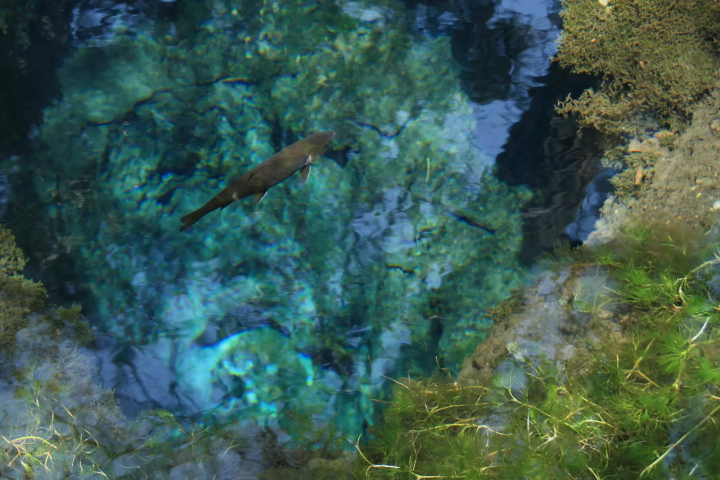
Picture of courtesy PIXTA
Oshino is a small village in the Fuji Five Lakes region near Mount Fuji in Japan. It is known for Oshino Hakkai, its eight spring-fed ponds, collectively called "hakkai" (meaning "eight seas"). These ponds are revered for their clear, spring water that originates from the melted snow of Mount Fuji.
Oshino Hakkai has become a popular tourist destination for those visiting the area. With its traditional thatched-roof houses, the village offers a peaceful and picturesque setting with views of Mount Fuji in the background. The springs have been designated a natural monument in Japan and are part of the World Cultural Heritage site "Mount Fuji—Sacred Place and Source of Artistic Inspiration."

Picture of courtesy Klook
It is said that this area was once the sixth lake at the foot of Mount Fuji, Lake Utsu, which split into two, forming Lake Oshino and Lake Yamanaka after a massive eruption of Mount Fuji around 800 AD. Over time, Lake Oshino dried up and turned into a basin, leaving behind several spring ponds, with the most representative being the eight ponds known as Oshino Hakkai.
During the Edo period (1603-1868), it became a significant spiritual site due to the popularity of Mount Fuji worship. Devotees would purify themselves in these ponds before climbing the mountain. In 1843, the ponds were dedicated to the Eight Great Dragon Kings, starting with Deaike as the first spiritual site and Shobuike as the eighth, forming a pilgrimage route, which has now evolved into the tourist route of Oshino Hakkai.
How to Get to Oshino Hakkai
The nearest station to Oshino Hakkai is Fujiyoshida Station, but since tourists often combine it with Lake Kawaguchi attractions, we'll first introduce the transportation from Lake Kawaguchi to Oshino Hakkai, followed by transportation options from Tokyo and other areas.
From Lake Kawaguchi to Oshino Hakkai
Take the Fujikyu bus from Kawaguchiko Station and get off at the "Oshino Hakkai" bus stop; the ride takes about 30 minutes. If you depart from Fujiyoshida Station, take the same bus route, which takes approximately 20 minutes.
Please refer to the official timetable.
From Tokyo to Oshino Hakkai
By Highway Bus
- Shinjuku Bus Terminal → (Take the Chuo Highway Bus/Approximately 140 minutes) → Oshino Hakkai
- Tokyo Station Bus Terminal → (Take the Highway Bus/Approximately 120 minutes) → Fujiyoshida Station → (Take the Fujikyu Bus/Approximately 20 minutes) → Oshino Hakkai
By Train
- JR Shinjuku Station → (Take the JR Chuo Line/90 minutes) → Otsuki Station → (Take the Fujikyu Railway/50 minutes) → Fujiyoshida Station → (Take the Fujikyu Bus/Approximately 20 minutes) → Oshino Hakkai
- JR Shinjuku Station → (Take the JR Chuo Line/90 minutes) → Otsuki Station → (Take the Fujikyu Railway/50 minutes) → Kawaguchiko Station → (Take the Fujikyu Bus/Approximately 30 minutes) → Oshino Hakkai
From Nagoya
By Highway Bus
- Meitetsu Bus Transfer Station in Nagoya → (Take the Chuo Highway Bus/Approximately 5 hours) → Fujiyoshida Station → (Take the Fujikyu Bus/Approximately 20 minutes) → Oshino Hakkai
By Train
- JR Nagoya Station → (Take the Shinkansen/90 minutes) → Mishima Station → (Take the Mishima-Kawaguchiko Liner Highway Bus/70 minutes) → Fujisan-Yamanakako Station → (Take the Fujikyu Bus/Approximately 15 minutes) → Oshino Hakkai
Use a Cost-Efficient Tourist Pass
The 2-Day Mt.Fuji & Fuji Five Lakes Passport (Fujikyu Railway Included)
Enjoy unlimited rides within the Mount Fuji and Fuji Five Lakes region on regional bus routes and tour buses for two days. You can also use the Fujikyu Railway between Otsuki Station and Kawaguchiko Station.
Adult: 4,700 yen, Child: 2,360 yen
*Additional limited express or reserved seat tickets are required when taking limited express trains.
For more details, please refer to the official website for information: https://e.fujikyu-railway.jp/ticket/
The Eight Ponds of Oshino Hakkai
Courtesy of Oshino Village Tourism Association
Below is an introduction to the Oshino Hakkai ponds. Please refrain from throwing coins into the ponds to avoid disrupting the water quality.
1. Deguchi-ike Pond
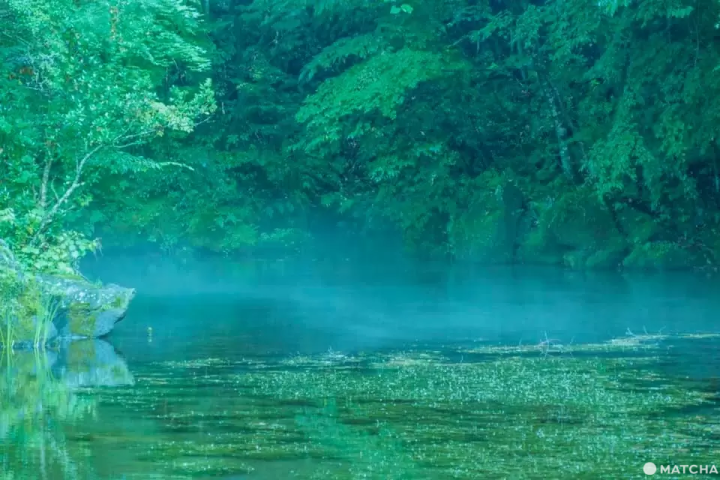
Deguchi-ike is the largest and relatively furthest pond among the Oshino Hakkai, attracting fewer tourists, offering a tranquil and serene atmosphere, and providing the most authentic experience of the natural beauty of Oshino Hakkai.
Due to its relative distance, while other ponds are likened to the Big Dipper constellation, Deguchiike is symbolized as the "North Star."
Guardian Deity: Dragon King Nanda
2. Okama-ike Pond

Picture of courtesy PIXTA
Okama-ike Pond is the smallest spring-fed pond among the Oshino Hakkai, deriving its name from the bubbling spring that resembles boiling water in a kettle. Growing within the pond are water plants, such as the beautiful "plum blossom algae," swaying gracefully in the clear and deep blue water.
Guardian Deity: Dragon King Upananda
3. Sokonashiike Pond
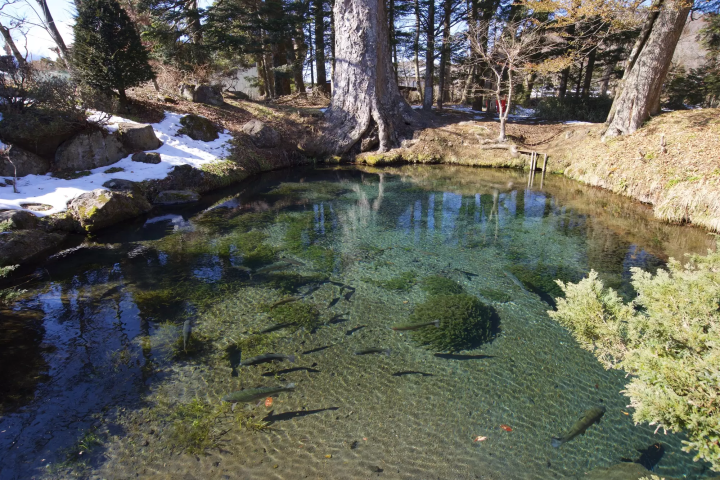
Picture of courtesy PIXTA
Sokonashiike Pond is the only spring-fed pond among the eight ponds of Oshino Hakkai that is situated within a privately-owned area, requiring an additional fee for entry.
It is also one of the best-preserved ponds with an old-world charm, and it is said to be interconnected with Okame-ike. There is a legend associated with Sokonashiike Pond that states "anything washed in the pond's waters will disappear."
As Sokonashiike Pond is located within the premises of the Hannoki Forest Museum (Hannoki Forest Museum), there is an entry fee of 300 yen, and please be mindful of the museum's opening hours from 9:00 to 17:00.
Guardian Deity: Dragon King Sagara
4. Choshi-ike Pond
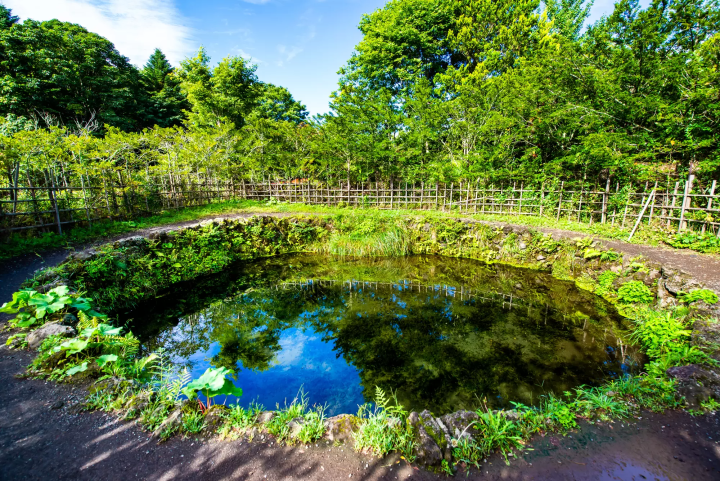
Picture of courtesy PIXTA
Choshi-ike, named for its resemblance to a pouring sake bottle called choshi, features clear water that allows for a fascinating view of the spring water erupting through the sandy bottom. This pond is also associated with the legend of "forming good relationships."
Guardian Deity: Dragon King Vasuki
5. Waku-ike Pond
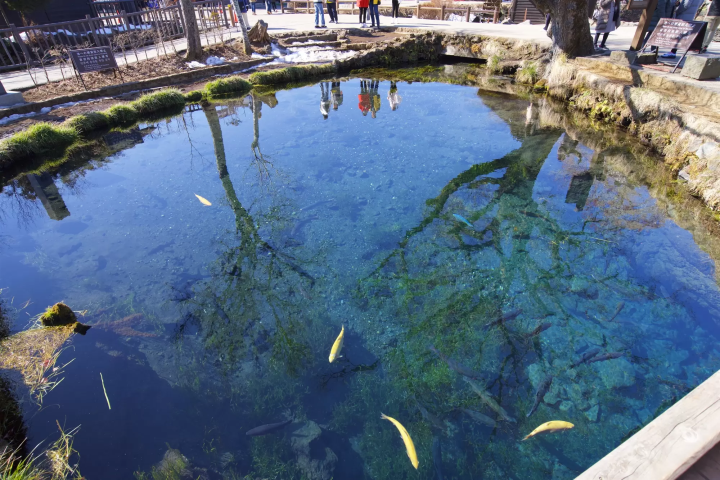
Picture of courtesy PIXTA
Waku-ike Pond is the most voluminous and representative spring-fed pond among the Oshino Hakkai ponds.
Known for its high transparency, the pond's clear waters allow for a view of the swaying water plants against a deep blue sky, making it a popular spot for photography. Adjacent to the pond, there are souvenir shops, attracting a constant stream of visitors.
Guardian Deity: Dragon King Takshaka
6. Nigori-ike Pond
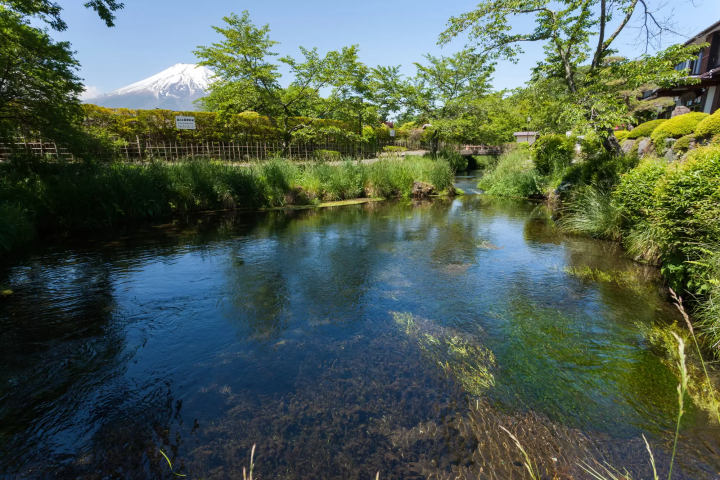
Picture of courtesy PIXTA
Nigori-ike, situated adjacent to Waku-ike, flows into the Ahara River.
Legend has it that in the past, a pilgrim seeking water was denied a cupful at this location, resulting in the pond's name - Nigoriike (meaning "muddy pond"). However, the pond's water is clear now and not muddy. Although the amount of spring water is minimal, there are indeed visible bubblings from the bottom of the pond.
Guardian Deity: Dragon King Anavatapta
7. Kagamiike Pond
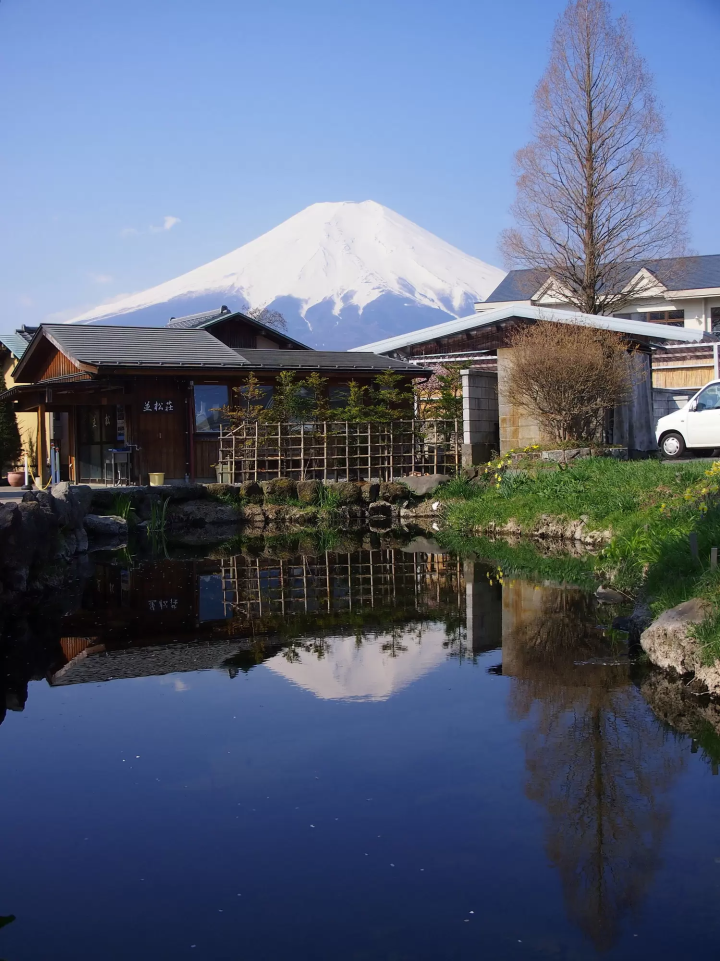
Picture of courtesy PIXTA
Kagamiike is located to the north of Waku-ike but has much less spring water, which varies with the phases of the moon.
Under ideal conditions, it can reflect the beautiful Mount Fuji, hence its name Kagamiike (meaning "Mirror Pond"). Legend has it that the waters of Kagamiike have the ability to distinguish between good and evil in the world.
Guardian Deity: Dragon King Manasvin
8. Shobuike Pond
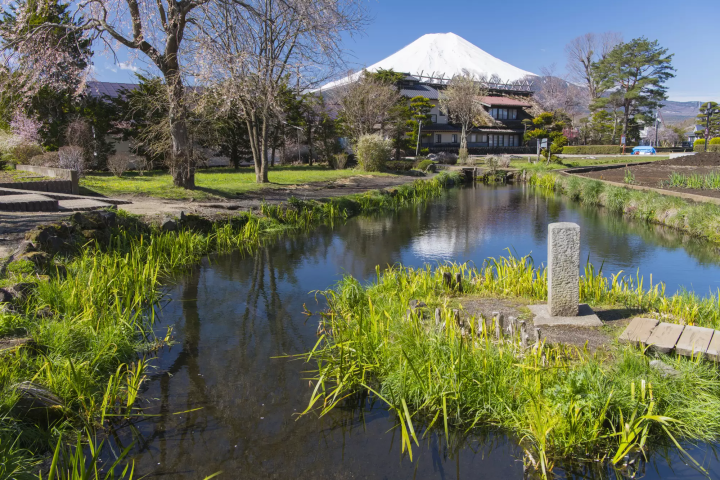
Picture of courtesy PIXTA
On the eastern side of Kagamiike, there is a pond called Shobuike, surrounded by a large number of irises. When they bloom, they create a picturesque scene against Mount Fuji, making it exceptionally beautiful.
Guardian Deity: Dragon King Utpalaka
The Artificial Nakaike Pond

Picture of courtesy PIXTA
The artificial pond Nakaike, not considered one of the Oshino Hakkai ponds, is surrounded by thatched-roof houses and waterwheels, and offers a view of Mount Fuji in the distance, creating a picturesque setting that makes it one of the most popular photography spots.
Attractions Near Oshino Hakkai
What else is there to explore near Oshino Hakkai? Check out the editor's picks for recommended places!
Lake Yamanaka

Picture courtesy of Yamanashi Prefecture Tourism Promotion Organization
Lake Yamanaka is the largest lake in the Fuji Five Lakes region and the one closest to Mount Fuji. Surrounding Lake Yamanaka are various spots ideal for capturing views of Mount Fuji, making it a popular destination. Visitors can enjoy activities such as boating and cycling around the lake to appreciate the beauty of Mount Fuji.
Lake Kawaguchiko

Picture courtesy of Yamanashi Tourism Promotion Organization
Lake Kawaguchiko is a renowned spot for viewing Mount Fuji. With Mount Fuji as its backdrop, the lake offers cherry blossoms in spring, lavender fields in summer, and autumn foliage, making it beautiful throughout the seasons.
The Nijumagari Pass Observation Deck
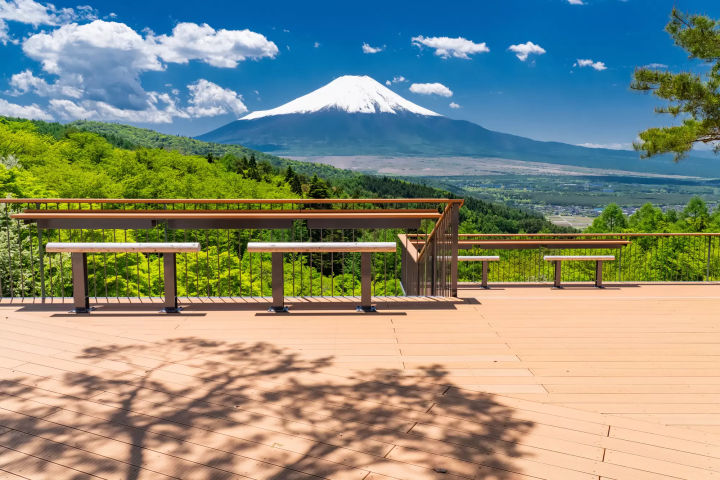
Picture of courtesy PIXTA
The Nijumagari Pass Observation Deck is situated at an altitude of 1,155 meters, offering a magnificent panoramic view of the Oshino Basin and Mount Fuji.
Address: Naike, Oshino Village, Minamitsuru District, Yamanashi Prefecture
Local Food at Oshino Hakkai
Clear Spring Water Soba Noodles: Ikemoto Teahouse
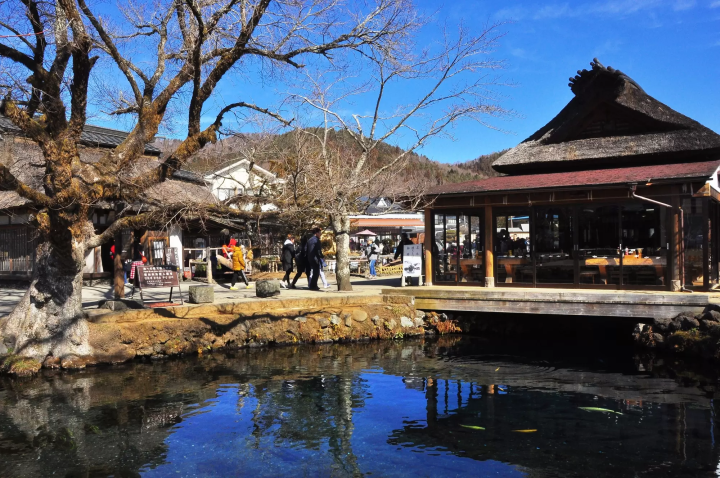
Picture of courtesy PIXTA
Made from water sourced from Mount Fuji, the soba noodles are a specialty cuisine of the Oshino Hakkai area, with Ikemoto Teahouse near Nakaike being the most famous spot.
In addition to their signature soba noodles, the teahouse also serves dishes like freshly grilled river fish cultivated in clean water and tempura, offering a taste of authentic Japanese cuisine.
Kusa Mochi Glutinous Rice Cakes
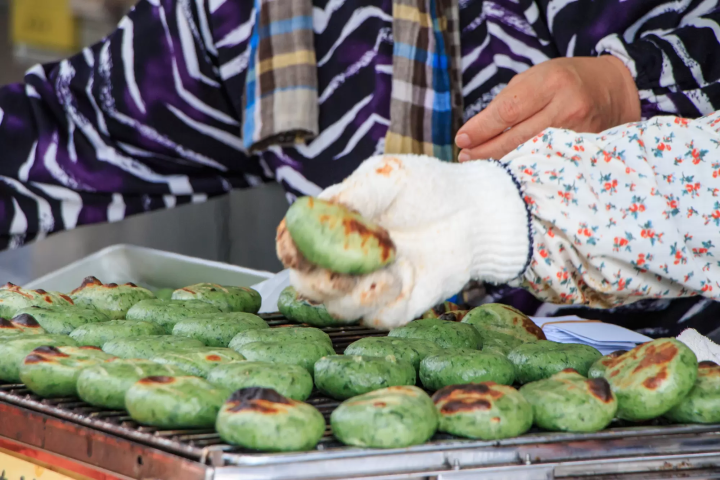
Picture of courtesy PIXTA
The freshly grilled Kusa Mochi, with a slightly herbal taste from the mugwort in the dough, paired with moderately sweet red bean paste, is a renowned local snack in the Oshino Hakkai area.
The Kusa Mochi treats are quite common in the Oshino Hakkai region, especially during autumn and winter; holding a hot Kusa Mochi in your hand warms your heart, enhancing its deliciousness!
Explore the Beautiful Oshino Hakkai!
The melted snow from Mount Fuji filters through underground lava before emerging in Oshino Village, forming the eight spring-fed ponds known as Oshino Hakkai.
The water here is crystal clear, with some ponds revealing depths several feet below, while others mirror the sky, reflecting Mount Fuji on clear days. Each pond is also considered a sacred site. Visiting them in order provides a sense of spiritual fulfillment.
The next time you visit Mount Fuji, why not experience the purification pilgrimage of ancient times by visiting Oshino Hakkai?
I used to live in Japan and managed to conquer 78 out of the 100 famous castles and 12 existing castle towers in 8 years. As a history enthusiast, I also have a passion for baseball and Japanese dramas, which have driven me to visit all 47 prefectures. I hope to convey not only the scenery of Japan but also more of its culture and way of life.







































![[2026] Top 5 Strawberry Picking Spots in Tokushima, Naruto| Farms and Access Guide for January to May](https://resources.matcha-jp.com/resize/720x2000/2025/03/06-227165.webp)

